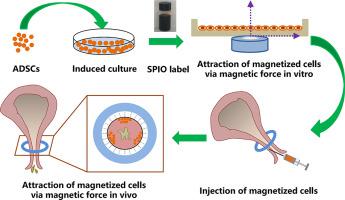Nanomedicine: Nanotechnology, Biology and Medicine ( IF 5.4 ) Pub Date : 2020-08-05 , DOI: 10.1016/j.nano.2020.102281 Ying Wang 1 , Shukui Zhou 2 , Ranxing Yang 3 , Mahbubur Rahman 4 , Russel Clive Sequeira 5 , Nailong Cao 1 , Yang Zhang 6 , Weixin Zhao 5 , Qiang Fu 1

|
Cell-based injectable therapy utilizing stem cells is a promising approach for the treatment of stress urinary incontinence (SUI). Applying a magnetically controlled cell delivery approach has enormous potential to enhance cell retention capability within the specified site. To assess the therapeutic efficacy of cellular magnetic targeting, we applied an external magnetic force to target an adipose-derived stem cell based therapy in a rat model of SUI. The results revealed that magnetic attraction of transplanted cells under the magnetic field was generated by cell uptake of superparamagnetic iron oxide nanoparticles in vitro. More importantly, magnetic targeting improved the retention rate of transplanted cells and facilitated the restoration of sphincter structure and function in a rat SUI model according to the results of histological examination and urodynamic testing. Therefore, magnetically guided targeting strategy might be a potential therapy method for treatment of SUI.
中文翻译:

在压力性尿失禁大鼠模型中超顺磁性氧化铁纳米颗粒标记的肌源性脂肪源性干细胞的磁性靶向。
利用干细胞的基于细胞的注射疗法是治疗压力性尿失禁 (SUI) 的一种很有前景的方法。应用磁控细胞递送方法具有提高指定部位内细胞保留能力的巨大潜力。为了评估细胞磁性靶向的治疗效果,我们在 SUI 大鼠模型中应用外部磁力来靶向基于脂肪干细胞的疗法。结果表明,移植细胞在磁场下的磁吸引力是由细胞在体外摄取超顺磁性氧化铁纳米颗粒而产生的。更重要的是,根据组织学检查和尿动力学检测结果,磁性靶向提高了移植细胞的保留率,促进了大鼠 SUI 模型中括约肌结构和功能的恢复。因此,磁引导靶向策略可能是治疗 SUI 的潜在治疗方法。


























 京公网安备 11010802027423号
京公网安备 11010802027423号